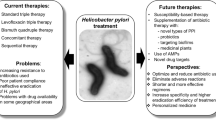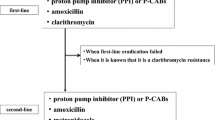Abstract
Background
P-glycoprotein (P-gp) is an Adenosine triphosphate (ATP) dependent drug-efflux pump which is located abundantly in the stomach and protects the gut mucosa from xenobiotic.
Objective
The purpose of this study was to investigate the influence of P-gp modulation on the efficacy of treatment regimen.
Method
P-gp modulation in rats was performed by using P-gp inducer (150 mg/kg rifampicin) and P-gp inhibitor (10 mg/kg cyclosporine A) for 14 days prior to be infected with Helicobacter pylori (H. pylori). The rats were further divided into groups, which were normal control, vehicle control, antibiotics and omeprazole, antibiotics only and omeprazole only for another 2 weeks of treatment. The ulcer formation and P-gp expression were determined by using macroscopic evaluation and western blot analysis, respectively.
Results
The highest P-gp expression was shown in the induced P-gp rats (2.00 ± 0.68) while the lowest P-gp expression was shown in the inhibited P-gp rats (0.45 ± 0.36) compared to the normal P-gp rats. In all groups, the rats which were infected with H. pylori, had a significant increase (p < 0.05) in P-gp expression level and a more severe ulcer formation compared to the healthy rats. The ulcer developed at different levels in the rats with inhibited, induced, or normal P-gp expression. After receiving the standard therapy for H. pylori, it was observed that the healing rate for ulcer was increased to 91% (rats with inhibited P-gp expression), 82% (rats with induced P-gp expression) and 75% in rats with normal P-gp. The use of rifampicin to induce P-gp level was also shown to be effective in eradicating the H. pylori infection.
Conclusion
The synergism in the standard therapy by using two antibiotics (clarithromycin and amoxicillin) and proton pump inhibitor (omeprazole) have shown to effectively eradicate the H. pylori infection. Thus, P-gp expression influenced the effectiveness of the treatment.
Graphical abstract





Similar content being viewed by others
References
Silva R, Vilas-Boas V, Carmo H, Dinis-Oliveria RJ, Carvalho F, De Lourdes BM, et al. Modulation of P-glycoprotein efflux pump: induction and activation as a therapeutic strategy. Pharmacol Ther. 2015;149:1–123. https://doi.org/10.1016/j.pharmthera.2014.11.013.
Elmeliegy M, Vourhavis M, Guo C, Wang DD. Effect of P-glycoprotein (P-gp) inducers on exposure of p-gp substrates. Review of clinical drug-drug interaction studies. Clin Pharmacokinet. 2020;59(2726):699–714.
Palatini P, Martin SR. Pharmacokinetic drug interactions in liver disease: an update. World J Gastroenterol. 2016;22(3):1260–78.
Fu D. Where is it and how does it get there – intracellular localization and traffic p-glycoprotein. Front Oncol. 2013;3(321):1–5.
Lin JH. Drug-drug interaction mediated by inhibition and induction of p-glycoprotein. Adv Drug Deliv Rev. 2003;55(1):53–81. https://doi.org/10.1016/s0169-409x(02)00171-0.
Babic Z, Svoboda-Beusan L, Kuicisec-Tepes N, Dekaris D, Troskot R. Increased activity of P-glycoprotein multidrug transporter in patient with Helicobacter pylori infection. World J Gastroenterol. 2005;11:2720–5.
Mouly S, Paine MF. P-glycoprotein increases from proximal to distal regions of human small intestine. Pharm Res. 2003;20(10):1595–9.
Wessler S, Krisch LM, Elmer DP, Aberger F. From inflammation to gastric cancer – the importance of hedgehog/GLI signaling in Helicobacter pylori-induced chronic inflammatory and neoplastic diseases. Cell Commun Signal. 2017;15:15. https://doi.org/10.1186/s12964-017-0171-4.
Mbulaiteye SM, Hisada M, El-Omar EM. Helicobacter Pylori associated global gastric cancer burden. Front Biosci. 2009;14:1490–504.
Chey WD, Leontiadis GI, Howden CW, Steven F, Moss SF. ACG clinical guideline: treatment of Helicobacter pylori infection. Am J Gastroenterol. 2017;112:212–38.
Zhang M. High antibiotic resistance rate: a difficult issue for Helicobacter pylori eradication treatment. World J Gastroenterol. 2015;21(48):13432–7.
Cianci R, Montalto M, Pandolfi F, Gasbarrini GB, Cammarota G. Third-line rescue therapy for helicobacter pylori infection. World J Gastroenterol. 2006;12(15):2313–9. https://doi.org/10.3748/wjg.v12.i15.2313.
Omar MS, Damanhuri NS, Kumolosasi E. Influences of proton pump inhibitor on Helicobacter pylori adherence to the gastrointestinal cell lines. Turk J Gastroenterol. 2017;28(1):55–61.
Twentyman PR, Bleehen NM. Resistance modification by PSC-833, a novel non-immunosupressive cyclosporine a. Eur J Cancer. 1991;27(12):1639–42.
Colabufo NA, Francesco B, Maria GP, Elena C, Mariangela C, Carmela I, et al. Substrates, inhibitors and activators of P-glycoprotein: candidates for radiolabeling and imaging perspectives. Curr Top Med Chem. 2010;10:1703–14.
Liu X, Wang H, Zhifa L, Wang Y, Wang B, Xie Y, et al. Rescue therapy with a proton pump inhibitor plus amoxicillin and rifabutin for Helicobacter pylori infection: a systematic review and meta-analysis. Gastroenterol Res Pract. 2015:1–11. https://doi.org/10.1155/2015/415648.
Howard-Jones N. A CIOMS Ethical Code for Animal Experimentation. WHO Chronicle. 1985;39(2):51–6.
Luo X, Yang T, Yang C, Zhou J, Liu Y, Huang Y, et al. Efffect of multiple oral dosing of cyclosporie on the pharmacokinetics of quercetin in rats. Int J Clin Exp Med. 2016;9(6):5880–90.
Sandström R, Lennernäs H. Repeated oral rifampicin decreases the jejunal permeability of R/S- verapamil in rats. Drug Metab Dispos. 1999;27(8):951–5.
Mahmood AA, Mariod AA, Al-Bayaty F, Abdel-Wahab SI. Antiulcerogenic activity of Gynura procumbens leaf extract against experimentally-induced gastric lesions in rats. J Med Plant Res. 2010;4(8):685–91.
Mahmood T, Yang PC. Western blot: technique, theory, and trouble shooting. N Am J Med Sci. 2012;4(9):429–34.
Zhuo W, Hu L, Lv J, Wang H, Zhou H, Fan L. Role of pregnane-x-receptor in chemotherapeutic treatment. Cancer Chemoth Pharm. 2014;74(2):217–27.
Kuster JG, Van Vliet HMA, Kuipers EJ. Pathogenesis of Helicobacter pylori infection. Clin Microbiol Rev. 2006;19(3):449–90.
Christians U, Schmitz V, Haschke M. Functional interactions between P-glycoprotein and CYP3A in drug metabolism. Expert Opin Drug Metab Toxicol. 2005;1(4):641–54. https://doi.org/10.1517/17425255.1.4.641.
Oesch F, Arand M, Benedetti MS, Castelli MG, Dostert P. Inducing properties of rifampicin and Rifabutin for selected enzyme activities of the cytochrome P-450 and UDP-glucuronosyltransferase Superfamilies in female rat liver. J Antimicrob Chemother. 1996;37:1111–9. https://doi.org/10.1093/jac/37.6.1111.
Luo G, Cunningham M, Kim S, Burn T, Lin J, Sinz M, et al. CYP3A4 induction by drugs: correlation between a pregnane-x-receptor reporter gene assay and CYP3A4 expression in human hepatocytes. Drug Metab Dispos. 2002;30:795–804.
Wang X, Sykes DB, Miller DS. Constitutive androstane receptor-mediated up-regulation of ATP-deriven xenobiotic efflux transporters at the blood brain barrier. Mol Pharmacol. 2010;78:376–83.
Lowest KS, Haslam IS, Fihn B, Hilgendorf C, Karlsson JE, Simmons NL, et al. The effect of pregnanolone 16α-carbonitrile dosing on digoxin pharmacokinetics and intestinal absortion in the rat. Pharmaceutics. 2010;2:61–77.
Ferreira RJ, Dos Santos DJ, Ferreira MJ. P-glicoprotein and membrane roles in multidrug resistance. Future Med Chem. 2015;7(7):929–46.
Omar M, Crowe A, Richard P, Hooi EE, Tay CY, Hughes J. P-glycoprotein expression in Helicobacter pylori – positive patients: the influence of MDR1 C345TT polymorphism. J Dig Dis. 2012;13:414–20.
Nardone G, Rocco A, Vaira D, Staibano S, Budillon A, Tatangelo F, et al. Expression of COX-2, mPGE-synthase1, MDR-1 (P-gp), and Bcl-x L : a molecular pathway of Helicobacter pylori related gastric carcinogenesis. J Pathol. 2004;202(3):305–12.
Shao Y, Sun K, Xu W, Li X, Shen H, Sun W. Helicobacter pylori infection, gastrin and Cyclooxygenase-2 in gastric carcinogenesis. World J Gastroenterol. 2014;20(36):12860–73.
Patel VA, Dunn MJ, Sorokin A. Regulation of MDR1 (P-glycoprotein) by Cyclooxygenase-2. J Biol Chem. 2002;277(41):38915–20.
Wu W, Yang Y, Sun G. Recent insights into antibiotic resistance in Helicobacter pylori eradication. Gastroenterol Res Pract. 2012;8:1–8.
Tay CY, Windsor HM, Thirriot F, Lu W, Conway C, Perkins TT, et al. Helicobacter pylori eradication in Western Australia using novel quadruple therapy combination. Aliment Pharmacol Ther. 2012;36:1076–83.
Helmenstine AM. pKa Definition in Chemistry. ThoughtCo, thoughtco.com/what-is-pka-in-chemistry-605521. [Feb. 11, 2020].
Babic S, Horvat AJM, Pavlovic DM, Macan MK. Determination of Pka value of active pharmaceutical ingredients. Trac- Trend Anal Chem. 2007;26(11):1043–61.
Hancu G, Naecsu A, Papp LA, Ciurba A. Simultaneous determination of amoxicillin and Calvulanic acid in pharmaceutical preparation by capillary zone electrophoresis. Braz J Pharm Sci. 2016;52(2):281–6.
Paulli-Magnus C, Rekersbrink S, Klotz U, Fromm MF. Interaction of omeprazole, Lansoprazole, and pantoprazole with P-glycoprotein. Naunyn Schmiedeberg’s Arch Pharmacol. 2001;364:551–7.
Lam A, Hoang JD, Singleton A, Han X, Bleier BS. Itraconazole and Chlaritromycin inhibit P-glycoprotein activity in primary human Sinonasal epithelial cell. Int Forum Allergy Rhinol. 2015;5(6):477–80.
Marcus EA, Sachs G, Scott DR. Eradication of Helicobacter pylori infection. Curr Gastroenterol Rep. 2016;18(7):33. https://doi.org/10.1007/s11894-016-0509-x.
Acknowledgments
This study was funded by Universiti Kebangsaan Malaysia with grant no. GGPM 2013-094. Special thanks to Dr. Alfizah Hanafiah (PPUKM) for providing the bacterial sample.
Availability of data and materials
Data generated or analyzed during this study was included in this article.
Author information
Authors and Affiliations
Contributions
EK and MSO planned the experimental phase and NSD and AHM performed the experiments and carried out the statistical analysis. EK and MSO conceptualized the study design and AFAR coordinated the research activities. The manuscript was written by NSD, MSO and reviewed by EK. All authors have read and approved the manuscript.
Corresponding author
Ethics declarations
Conflict of interest
The authors declared that they have no conflict of interest.
Ethical approval
The study was approved by Universiti Kebangsaan Malaysia Animal Ethics Committee, (UKMAEC) under the approval number FF/2015/ENDANG/29-SEPT./699-SEPT.-2015-SEPT in accordance with the international guidelines for animal studies (WHO Chronicle, 1985) [17].
Consent for publication
Not applicable.
Additional information
Publisher’s note
Springer Nature remains neutral with regard to jurisdictional claims in published maps and institutional affiliations.
Rights and permissions
About this article
Cite this article
Damanhuri, N.S., Kumolosasi, E., Omar, M.S. et al. The influence of P-glycoprotein expression in the standard treatment of Helicobacter pylori infection in Sprague Dawley rats. DARU J Pharm Sci 29, 13–22 (2021). https://doi.org/10.1007/s40199-020-00377-2
Received:
Accepted:
Published:
Issue Date:
DOI: https://doi.org/10.1007/s40199-020-00377-2




